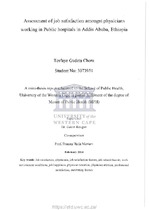| dc.contributor.advisor | Reagon, Gavin | |
| dc.contributor.author | Cheru, Tesfaye Gudeta | |
| dc.date.accessioned | 2021-04-20T12:29:02Z | |
| dc.date.available | 2021-04-20T12:29:02Z | |
| dc.date.issued | 2014 | |
| dc.identifier.uri | http://hdl.handle.net/11394/8220 | |
| dc.description | Magister Public Health - MPH | en_US |
| dc.description.abstract | Introduction
The Human Resource Strategic Plan of the Ethiopian Ministry of Health lists current health workforce problems as a high attrition rate among public service physicians, poor human resource management, non-conducive working conditions and high workloads. In Addis Ababa's
public hospitals, the turnover of physicians is high and - as repeatedly and informally reported by hospital managers - the presence of the contributory factors listed above are also anecdotally thought to be present. These factors present a serious challenge to the delivery of high quality health care services and their presence indicates that the job satisfaction of physicians is likely to be low. However, factors responsible for job dissatisfaction among physicians and their implications for staff turnover have not been studied or documented in the context of Ethiopia's health system. It was this scenario that motivated the researcher to conduct this study in order to assist policy makers in taking appropriate actions, if and as required. Aim: The aim of the study was to assess the level of job satisfaction, the factors influencing job
satisfaction and the consequences of job satisfaction among physicians in public hospitals in Addis Ababa, Ethiopia. Objectives: • To describe the job satisfaction levels of physicians in public hospitals in Addis Ababa, Ethiopia • To identify factors affecting the job satisfaction levels of physicians • To assess possible consequences linked to physicians' job satisfaction levels. A self-administered questionnaire was used to measure job satisfaction, composed of 65 individual variables grouped within 13 dimensions and adapted to the Ethiopian context from the
Job Descriptive Index and the Minnesota Satisfaction Questionnaire. An additional questionnaire was used to assess socio-demographic variables and the possible consequences of low job satisfaction. Analysis: A composite job satisfaction score was obtained by summing the individual answers for each of the variables to assess overall job satisfaction. Bivariate analysis was undertaken, using 2X2 tables (with 95% confidence intervals) to calculate the prevalence ratio for each of the potential causes and consequences of low job satisfaction, using the composite score cut-off levels of job satisfaction. Multivariate analysis was undertaken to obtain the adjusted prevalence odds ratios
for both the potential causes and consequences of low job satisfaction, using multiple logistic regression analysis. | en_US |
| dc.language.iso | en | en_US |
| dc.publisher | University of the Western Cape | en_US |
| dc.subject | Job satisfaction | en_US |
| dc.subject | Physicians | en_US |
| dc.subject | Job satisfaction factors | en_US |
| dc.subject | Job-related factors | en_US |
| dc.subject | Work environment conditions | en_US |
| dc.subject | Job happiness | en_US |
| dc.subject | Physician retention | en_US |
| dc.subject | Physician attrition | en_US |
| dc.subject | Professional satisfaction | en_US |
| dc.subject | Motivating factors | en_US |
| dc.title | Assessment of job satisfaction amongst physicians working in Public hospitals in Addis Ababa, Ethiopia | en_US |
| dc.rights.holder | University of the Western Cape | en_US |

